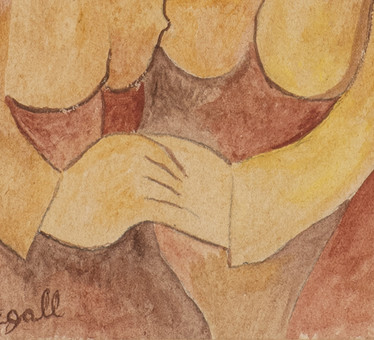Lasar Segall

Vilnius, Lithuania, 1889 —
São Paulo, Brazil, 1957
It is inherent in Lasar Segall’s work a humanism full of lyricism and expressiveness, deeply embedded in the artistic and historical dilemmas of his time, giving way to an intense plastic formulation of the human drama that marks the 20th century, full of sadness but also of life.
Born in Vilnius, then part of the Russian Empire, Segall studied at the Academies of Fine Arts in Berlin and Dresden. His first paintings reveal the influence of impressionism and Dutch art, such as the works Asilo de Velhos (1912) and Leitura (1913), in which vibrant brushwork is combined with an exterior luminosity that focuses on the intimacy of the scenes. But even in this initial period, as in Vilna and me (1910), Segall’s work already announces a tendency towards expressionism that intensifies after the outbreak of the First World War, when works that reflect a dense meditation on human suffering gain space . Thus, works like Os Eternos Caminhadores (1919) were born, whose sober colors and angular figures communicate a sense of dehumanization and exile imposed on those victimized by violence and catastrophe.
In 1923, Segall emigrated to Brazil, allowing himself to be dazzled by the light and tropical colors. Feeling brotherly to the country, the artist paints Encontros (1924), a work in which he portrays himself with a skin tone characteristic of the Brazilian population. In dialogue with Brazilian modernism, Segall’s works focus on Brazil’s landscapes and human types, revealing sensitivity with marginalized social groups. In Morro Vermelho (1926), in front of the landscape of a favela, a black mother and boy embody the roles of Nossa Senhora and Menino Jesus, embraced in a touching and poetic bond.
In addition to the intimate canvases, there is the grandeur of the epic in Segall in a masterpiece like Navio de Emigrantes (1939/1941). The front arch of the immense ship painted in low tones is filled with human figures who look back, dominated by fatigue and desolation, as if they were a metonymy of an entire century surrounded by the melancholy of loss and exile. But the open sea and the sky of a tense luminosity, where the clouds are confused with the pigeons of peace, carry the ciphered announcement of a possible future, a nurturing of human hope that the artist makes flourish in the storms of an exhausted time. for the tragedy.
VRP